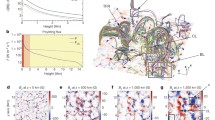Abstract
In order to discuss the detailed interactions between the magnetic and velocity fields below a sunspot, several models of the convection zone are considered. It is suggested that giant convection cells establish a pattern of large superadiabatic gradients near the top and bottom of the zone analogous with the temperature gradients in laboratory convection. These gradients in turn establish their own eddies or cells with dimensions typical of the local scale height. Those at the top correspond to the photospheric granules while overshoot motions from the bottom of the layer may be related to the surface supergranule motions.
The possibility that the surface supergranule motions are due to a counter-cell lying above a thermally driven supergranule cell are discussed and this concept is included in one of the models which may be typical of quiet regions of the convection zone. However, it is suggested that just prior to the appearance of a sunspot, overshoot motions from the deep eddy may extend almost to the top of the convection zone replacing the counter-cell by the motions of the cooling cycle discussed in paper I.
The magnetic power required by this cycle may be supplied by the upward drift of flux ropes expelled from and amplified by these elongated convection eddies. For a typical sunspot, an upper limit to the power required is 9 × 102 erg s−) = 13.46 - 2.99 sin21. Consideration of all forms of energy emitted from a sunspot and its immediate neighbourhood (including hydromagnetic waves and excess facular radiation) fails to account for 1.1 × 102 erg s−1) = 13.46 - 2.99 sin21 of the flux normally emitted through an equivalent area of the photosphere. Thus if this thermal and kinetic energy is converted to magnetic energy by the expulsion of flux from the convective eddies, the magnetic power requirements of the cooling mechanism may be readily satisfied.
Similar content being viewed by others
References
Beckers, J. M.: 1968, Solar Phys. 5, 309.
Beckers, J. M. and Schröter, E. H.: 1968, Solar Phys. 4, 142.
Cannon, C. J.: 1971, Solar Phys. 21, 82.
Edmonds, F. N. and Webb, E.: 1972, Solar Phys. 22, 276.
Frasier, E. N.: 1970, Solar Phys. 14, 89.
Giovanelli, R. G.: 1972, Private communication.
Kiepenheuer, K. O.: 1966, Proceedings of the Sunspot Symposium (ed. by G. Barbera), Florence, p. 26.
Korobova, Z. B., Tchandaev, A. K., and Vassilyeva, G. Y.: 1968, in K. O. Kiepenheuer (ed.), ‘Structure and Development of Solar Active Regions’, IAU Symp. 35, 151.
Palm, E.: 1960, J. Fluid Mech. 8, 183.
Piddington, J. H.: 1971, Solar Phys. 21, 4.
Savage, B. D.: 1969, Astrophys. J. 156, 707.
Sheeley, N. R.: 1969, Solar Phys. 9, 347.
Sheeley, N. R.: 1971, in R. Howard (ed.), ‘Solar Magnetic Fields’, IAU Symp. 43, 310.
Sheeley, N. R.: 1972, Solar Phys. 25, 98.
Sheeley, N. R. and Bhatnagar, A.: 1971, Solar Phys. 19, 338.
Simon, G. W. and Leighton, R. B.: 1964, Astrophys. J. 140, 1120.
Simon, G. W. and Weiss, N. O.: 1968, Z. Astrophys. 69, 435.
Spiegel, E. A.: 1966, Trans. IAU 12B, 539.
Tippelskirch, H. V.: 1956, Beitr. Phys. frei. Atmos. 29, 37.
Unno, W.: 1957, Astrophys. J. 126, 259.
Veronis, G.: 1963, Astrophys. J. 137, 641.
Vrabec, D.: 1971, in R. Howard (ed.), ‘Solar Magnetic Fields’, IAU Symp. 43, 329.
Weiss, N. O.: 1966, Proc. Roy. Soc. A239, 310.
Weiss, N. O.: 1968, in K. O. Kiepenheuer (ed.), ‘Structure and Development of Solar Active Regions’, IAU Symp. 35, 111.
Wilson, P. R.: 1968, Solar Phys. 3, 243.
Wilson, P. R.: 1971, Solar Phys. 21, 101.
Wilson, P. R.: 1972, this issue, p. 354.
Author information
Authors and Affiliations
Rights and permissions
About this article
Cite this article
Wilson, P.R. The cooling of a sunspot. Sol Phys 27, 363–372 (1972). https://doi.org/10.1007/BF00153108
Received:
Revised:
Issue Date:
DOI: https://doi.org/10.1007/BF00153108




